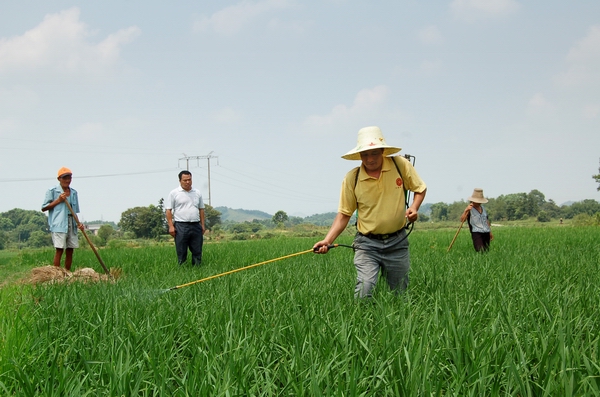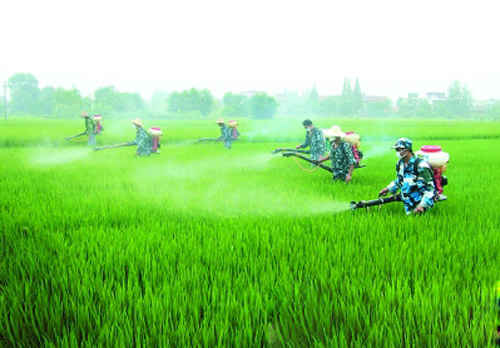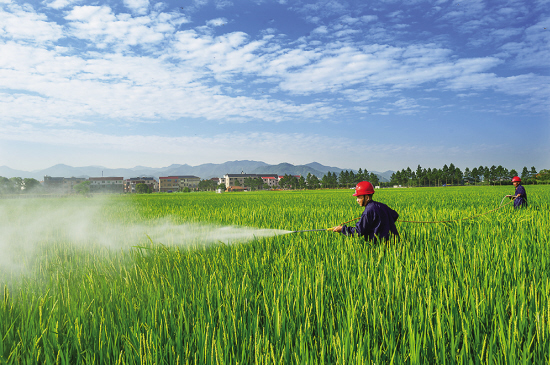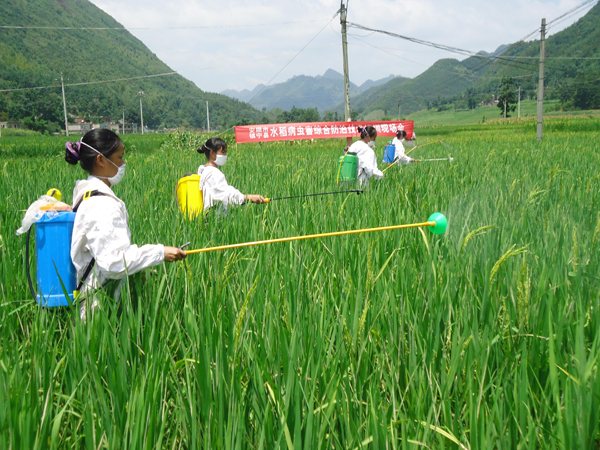Control methods of Rice Diseases and insect pests
Rice planthopper, rice leaf roller and panicle neck blast occurred greatly, while rice stem borer, sheath blight and rice false smut occurred moderately in the second generation. Prevention and control work should adhere to the strategy of "pressing the front and controlling the rear, treating the small early is the comprehensive control of early prevention". Focus on four key battles:
The first campaign: in the first and middle of July, the main targets of prevention and control were the second generation rice planthopper and the second generation rice leaf roller. When the number of rice planthoppers reached 100, the fields with more than 1200 insects were immediately treated with quick-acting pesticides such as chlorpyrifos and isoprocarb. 5-7 days after the emergence of adult moths in the field (or more than 60 moths per mu), recommended pesticides were used for control.

The second campaign: from late July to early August, the main targets for prevention and control were the third generation of rice planthopper, the third generation of rice leaf borer, the second generation of Chilo suppressalis, and the treatment of sheath blight. Before July 25, fipronil and thiazinones were widely applied in all the paddy fields in the county, and the fields of the second generation Chilo suppressalis, rice planthopper and rice leaf roller exceeded the standard after application, and quick-acting pesticides were used for emergency control. Combined with pest control, the fields with severe sheath blight should be treated with Jinggangmycin.
The third campaign: the rice break period (early and mid-August), the main object of prevention and control is panicle neck blast and rice false smut, pay attention to the emergency control of rice planthopper and rice leaf roller. Tricyclazole + Jinggangmycin + triadimefon or rice amide or love seedling EC were applied once at the breaking stage of rice (the simple judgment method was that there was one ear outcrop per seedling) to prevent neck blast and false smut. If Rain Water is more, apply Fuji No. 1 or Fuji No. 5 + triadimefon again at full heading and flowering stage. The occurrence of panicle neck blast is very serious in our county all the year round, and the harm is great. Medication prevention in the break stage is the key measure to control panicle neck blast, which must be paid great attention to. The fields of rice planthopper and rice leaf roller exceeding the standard should be urgently controlled by quick-acting chemicals.

The fourth campaign: from late August to early September, the main object of prevention and control was the fourth generation of rice planthopper to carry out emergency control in the fields with high amount of rice leaf borer. Fields with more than 5000 rice planthoppers should be drained, sprinkled with 80% dichlorvos 400ml mixed with fine soil and sprinkled with 30kg of fine soil. A day later, water will be returned, and spray control will be carried out as appropriate.
Prevention is the main way to prevent rice diseases and insect pests, and biophysical control with high efficiency, low toxicity and low residue is selected to ensure product quality and safety.
(1) key technologies: one protection, one leniency and three strictness, that is, paying attention to the protection of natural enemies of insect pests, relaxing the control standards appropriately, not applying pesticides indiscriminately, strictly applying pesticide types, strict application time, and strict application quantity.
(2) Chemical weeding: 5-7 days after rice planting, high-efficiency and low-residue herbicides were selected for chemical weeding. Use 24% ethoxyfluoxane (also known as Guoer) 10ml/ bag + 20% Acetochlor wettable powder 25g / bag per mu. It is used for 13 days after planting seedlings.
(3) the object of prevention and control:
Red blight: 200 grams of zinc sulfate per mu was dipped in seedling roots or sprayed with 200 grams of zinc sulfate per mu at the initial stage of the disease on the basis of shallow water management.
Rice blast: at the initial stage of the disease, 40% thiocyclazole 150 m / m 200 g / mu or 75% tricyclazole 20 m / mu was sprayed with water. Special attention should be paid to the prevention of rice neck blast.

Rice false smut: use 20% Jinggangmycin 50 g / mu and spray with water 20 days before heading.
Bacterial blight: at the initial stage of the disease, 25% Ye Kun Ning 100Mu 150 g / mu or Kuikuning 100 g / mu was sprayed with water.
Rice armyworm, locust: spray with biological pesticide BT400 ml / mu or 20% perchlorophos (insect transfer) 40 ml / mu with water at the age of 1 ml / mu.
Rice field rodent damage: control with 250 g / mu of 0.5% bromadiolone bait.
Rice pest
1. Rice planthopper
Symptoms: in order to harm rice, the leaf tip turns golden and then dies, adults and nymphs are clustered to feed on the lower part of the rice plant, piercing the tissue of the rice plant with piercing mouthparts and sucking sap, causing the lower part of the rice plant to blacken and lodge when the number of insects is large, resulting in a serious reduction in yield or loss of harvest.
Control methods: the planthopper inhabit, feed on the gully grass also need to be applied, choose any of the following chemicals.
(1) 30% lice stripe, 35 grams per mu with 60 kilograms of water on a sunny day.
(2) 25% clenbuterol, 30 grams of water and 60 kilograms of water per mu.
(3) net planthopper, 30 grams of water and 60 kilograms of water per mu.

2. Borer
Symptom: tissue that feeds on rice with larvae. In the seedling stage and tillering stage, the decay from the base of the rice stem causes withered seedlings, invades in the early booting stage, causes withered booting, invades at the end of booting and early heading, bites off the ear neck, and causes white panicle.
Prevention and control methods:
The main results are as follows: (1) the control target field was selected, and the withered heart was investigated at the beginning of egg block hatching.
(2) determine the appropriate time for prevention and control and check the progress of egg block hatching.
(3) medicament: spray 90% insecticidal sheet 100 grams with 60 kg water per mu, or spray 50 grams with 98% Batan powder with 60 kg water per mu.
Bite off the neck of the ear, causing the white ear.
Prevention and control methods:
The main results are as follows: (1) the control target field was selected, and the withered heart was investigated at the beginning of egg block hatching.
(2) determine the appropriate time for prevention and control and check the progress of egg block hatching.
(3) medicament: spray 90% insecticidal sheet 100 grams with 60 kg water per mu, or spray 50 grams with 98% Batan powder with 60 kg water per mu.
Related
- Wuhan Hospital Iron Tree Blooming Result Was Instantly Frightened by the Gardener Master
- Which variety of camellia is the most fragrant and best? Which one do you like best?
- What is the small blue coat, the breeding methods and matters needing attention of the succulent plant
- Dormancy time and maintenance management of succulent plants during dormancy
- Minas succulent how to raise, Minas succulent plant pictures
- What are the varieties of winter succulent plants
- How to raise succulent plants in twelve rolls? let's take a look at some experience of breeding twelve rolls.
- Attention should be paid to water control for succulent plants during dormant period (winter and summer)
- Watering experience of twelve rolls of succulent plants
- Techniques for fertilizing succulent plants. An article will let you know how to fertilize succulent plants.



